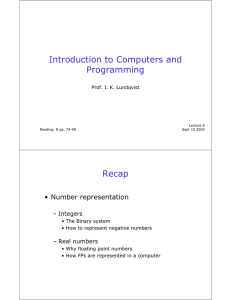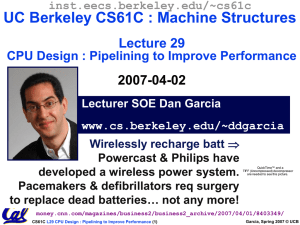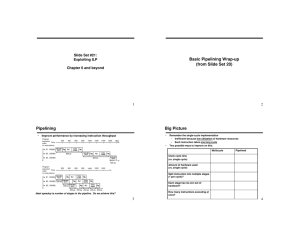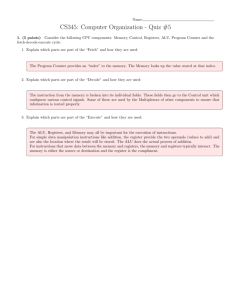2006Fa61C-L28-ddg-pi..
advertisement
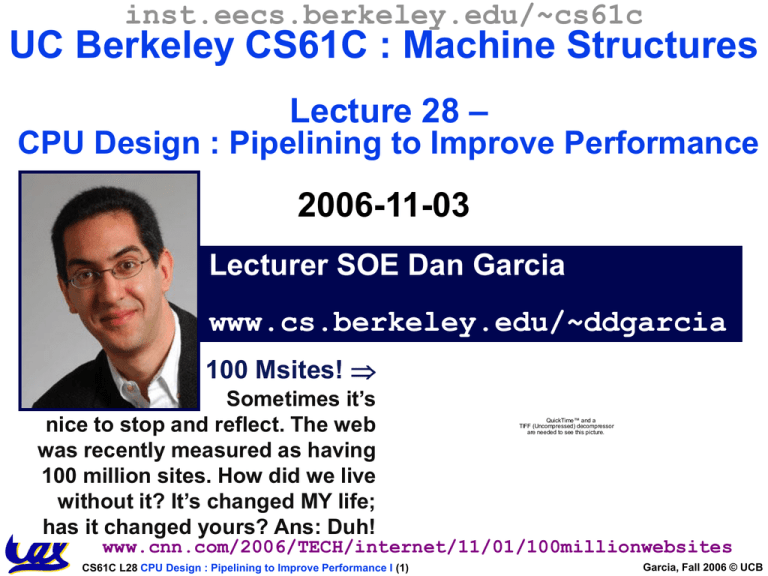
inst.eecs.berkeley.edu/~cs61c UC Berkeley CS61C : Machine Structures Lecture 28 – CPU Design : Pipelining to Improve Performance 2006-11-03 Lecturer SOE Dan Garcia www.cs.berkeley.edu/~ddgarcia 100 Msites! Sometimes it’s nice to stop and reflect. The web was recently measured as having 100 million sites. How did we live without it? It’s changed MY life; has it changed yours? Ans: Duh! QuickTime™ and a TIFF (Uncompressed) decompressor are needed to see this picture. www.cnn.com/2006/TECH/internet/11/01/100millionwebsites CS61C L28 CPU Design : Pipelining to Improve Performance I (1) Garcia, Fall 2006 © UCB Review: Single cycle datapath °5 steps to design a processor • 1. Analyze instruction set datapath requirements • 2. Select set of datapath components & establish clock methodology • 3. Assemble datapath meeting the requirements • 4. Analyze implementation of each instruction to determine setting of control points that effects the register transfer. Processor Input • 5. Assemble the control logic Control °Control is the hard part °MIPS makes that easier Memory Datapath • Instructions same size • Source registers always in same place • Immediates same size, location • Operations always on registers/immediates CS61C L28 CPU Design : Pipelining to Improve Performance I (2) Output Garcia, Fall 2006 © UCB How We Build The Controller RegDst ALUSrc MemtoReg RegWrite MemWrite nPCsel Jump ExtOp ALUctr[0] ALUctr[1] opcode func = add + sub = ori + lw + sw add = lw sub ori = add + sub + ori + lw lw = sw “OR” logic “AND” logic sw = beq beq = jump jump = lw + sw = sub + beq (assume ALUctr is 0 ADD, 01: SUB, 10: OR) = or RegDst ALUSrc MemtoReg RegWrite MemWrite nPCsel Jump ExtOp ALUctr[0] ALUctr[1] where, rtype = ~op5 ~op4 ~op3 ~op2 ori = ~op5 ~op4 op3 op2 lw = op5 ~op4 ~op3 ~op2 sw = op5 ~op4 op3 ~op2 beq = ~op5 ~op4 ~op3 op2 jump = ~op5 ~op4 ~op3 ~op2 ~op1 ~op0, ~op1 op0 op1 op0 op1 op0 ~op1 ~op0 op1 ~op0 How do we implement this in gates? add = rtype func5 ~func4 ~func3 ~func2 ~func1 ~func0 sub = rtype func5 ~func4 ~func3 ~func2 func1 ~func0 CS61C L28 CPU Design : Pipelining to Improve Performance I (3) Garcia, Fall 2006 © UCB Processor Performance • Can we estimate the clock rate (frequency) of our single-cycle processor? We know: • 1 cycle per instruction •lw is the most demanding instruction. • Assume approximate delays for major pieces of the datapath: Instr. Mem, ALU, Data Mem : 2ns each, regfile 1ns Instruction execution requires: 2 + 1 + 2 + 2 + 1 = 8ns 125 MHz • What can we do to improve clock rate? • Will this improve performance as well? • We want increases in clock rate to result in programs executing quicker. CS61C L28 CPU Design : Pipelining to Improve Performance I (4) Garcia, Fall 2006 © UCB Gotta Do Laundry ° Ann, Brian, Cathy, Dave each have one load of clothes to wash, dry, fold, and put away A B C D ° Washer takes 30 minutes ° Dryer takes 30 minutes ° “Folder” takes 30 minutes ° “Stasher” takes 30 minutes to put clothes into drawers CS61C L28 CPU Design : Pipelining to Improve Performance I (5) Garcia, Fall 2006 © UCB Sequential Laundry 6 PM 7 T a s k O r d e r A 8 9 10 11 12 1 2 AM 30 30 30 30 30 30 30 30 30 30 30 30 30 30 30 30 Time B C D • Sequential laundry takes 8 hours for 4 loads CS61C L28 CPU Design : Pipelining to Improve Performance I (6) Garcia, Fall 2006 © UCB Pipelined Laundry 6 PM 7 T a s k 8 9 3030 30 30 30 30 30 10 11 12 1 2 AM Time A B C O D r d e • Pipelined r 3.5 hours laundry takes for 4 loads! CS61C L28 CPU Design : Pipelining to Improve Performance I (7) Garcia, Fall 2006 © UCB General Definitions • Latency: time to completely execute a certain task • for example, time to read a sector from disk is disk access time or disk latency • Throughput: amount of work that can be done over a period of time CS61C L28 CPU Design : Pipelining to Improve Performance I (8) Garcia, Fall 2006 © UCB Pipelining Lessons (1/2) 6 PM T a s k 8 9 Time 30 30 30 30 30 30 30 A B O r d e r 7 C D • Pipelining doesn’t help latency of single task, it helps throughput of entire workload • Multiple tasks operating simultaneously using different resources • Potential speedup = Number pipe stages • Time to “fill” pipeline and time to “drain” it reduces speedup: 2.3X v. 4X in this example CS61C L28 CPU Design : Pipelining to Improve Performance I (9) Garcia, Fall 2006 © UCB Pipelining Lessons (2/2) • Suppose new Washer takes 20 6 PM 7 8 9 minutes, new Time T Stasher takes 20 a 30 30 30 30 30 30 30 minutes. How s A much faster is k pipeline? B O r d e r C D • Pipeline rate limited by slowest pipeline stage • Unbalanced lengths of pipe stages reduces speedup CS61C L28 CPU Design : Pipelining to Improve Performance I (10) Garcia, Fall 2006 © UCB Steps in Executing MIPS 1) IFtch: Instruction Fetch, Increment PC 2) Dcd: Instruction Decode, Read Registers 3) Exec: Mem-ref: Calculate Address Arith-log: Perform Operation 4) Mem: Load: Store: Read Data from Memory Write Data to Memory 5) WB: Write Data Back to Register CS61C L28 CPU Design : Pipelining to Improve Performance I (11) Garcia, Fall 2006 © UCB Pipelined Execution Representation Time IFtch Dcd Exec Mem WB IFtch Dcd Exec Mem WB IFtch Dcd Exec Mem WB IFtch Dcd Exec Mem WB IFtch Dcd Exec Mem WB IFtch Dcd Exec Mem WB • Every instruction must take same number of steps, also called pipeline “stages”, so some will go idle sometimes CS61C L28 CPU Design : Pipelining to Improve Performance I (12) Garcia, Fall 2006 © UCB +4 1. Instruction Fetch ALU Data memory rd rs rt registers PC instruction memory Review: Datapath for MIPS imm 5. Write 2. Decode/ 3. Execute 4. Memory Back Register Read • Use datapath figure to represent pipeline IFtch Dcd Exec Mem WB Reg CS61C L28 CPU Design : Pipelining to Improve Performance I (13) ALU I$ D$ Reg Garcia, Fall 2006 © UCB Graphical Pipeline Representation (In Reg, right half highlight read, left half write) Time (clock cycles) Reg Reg D$ Reg I$ Reg D$ Reg I$ Reg ALU D$ Reg I$ Reg ALU I$ D$ ALU Reg ALU I$ ALU I n s Load t Add r. Store O Sub r d Or e r D$ CS61C L28 CPU Design : Pipelining to Improve Performance I (14) Reg Garcia, Fall 2006 © UCB Example • Suppose 2 ns for memory access, 2 ns for ALU operation, and 1 ns for register file read or write; compute instr rate • Nonpipelined Execution: •lw : IF + Read Reg + ALU + Memory + Write Reg = 2 + 1 + 2 + 2 + 1 = 8 ns •add: IF + Read Reg + ALU + Write Reg = 2 + 1 + 2 + 1 = 6 ns (recall 8ns for single-cycle processor) • Pipelined Execution: • Max(IF,Read Reg,ALU,Memory,Write Reg) = 2 ns CS61C L28 CPU Design : Pipelining to Improve Performance I (15) Garcia, Fall 2006 © UCB Pipeline Hazard: Matching socks in later load 6 PM 7 T a s k 8 9 3030 30 30 30 30 30 A 10 11 12 1 2 AM Time bubble B C O D r d E e r F A depends on D; stall since folder tied up CS61C L28 CPU Design : Pipelining to Improve Performance I (16) Garcia, Fall 2006 © UCB Administrivia • We know the readers are behind, a fire has been lit, and they say they’re on it • No lecture next Friday • Those who have lab on Friday should come to any lab in Thursday and do it • Worst case, you can do it at home and get it checked off next week CS61C L28 CPU Design : Pipelining to Improve Performance I (17) Garcia, Fall 2006 © UCB Problems for Pipelining CPUs • Limits to pipelining: Hazards prevent next instruction from executing during its designated clock cycle • Structural hazards: HW cannot support some combination of instructions (single person to fold and put clothes away) • Control hazards: Pipelining of branches causes later instruction fetches to wait for the result of the branch • Data hazards: Instruction depends on result of prior instruction still in the pipeline (missing sock) • These might result in pipeline stalls or “bubbles” in the pipeline. CS61C L28 CPU Design : Pipelining to Improve Performance I (18) Garcia, Fall 2006 © UCB Structural Hazard #1: Single Memory (1/2) Time (clock cycles) ALU I n I$ D$ Reg Reg s Load I$ D$ Reg Reg t Instr 1 r. I$ D$ Reg Reg Instr 2 O I$ D$ Reg Reg Instr 3 r I$ D$ Reg Reg d Instr 4 e r Read same memory twice in same clock cycle ALU ALU ALU ALU CS61C L28 CPU Design : Pipelining to Improve Performance I (19) Garcia, Fall 2006 © UCB Structural Hazard #1: Single Memory (2/2) • Solution: • infeasible and inefficient to create second memory • (We’ll learn about this more next week) • so simulate this by having two Level 1 Caches (a temporary smaller [of usually most recently used] copy of memory) • have both an L1 Instruction Cache and an L1 Data Cache • need more complex hardware to control when both caches miss CS61C L28 CPU Design : Pipelining to Improve Performance I (20) Garcia, Fall 2006 © UCB Structural Hazard #2: Registers (1/2) Reg Reg D$ Reg I$ Reg D$ Reg I$ Reg D$ Reg I$ Reg ALU I$ D$ ALU Reg ALU I$ ALU O Instr 2 r Instr 3 d e Instr 4 r Time (clock cycles) ALU I n s t sw r. Instr 1 D$ Reg Can we read and write to registers simultaneously? CS61C L28 CPU Design : Pipelining to Improve Performance I (21) Garcia, Fall 2006 © UCB Structural Hazard #2: Registers (2/2) • Two different solutions have been used: 1) RegFile access is VERY fast: takes less than half the time of ALU stage Write to Registers during first half of each clock cycle Read from Registers during second half of each clock cycle 2) Build RegFile with independent read and write ports • Result: can perform Read and Write during same clock cycle CS61C L28 CPU Design : Pipelining to Improve Performance I (22) Garcia, Fall 2006 © UCB Peer Instruction A. B. C. Thanks to pipelining, I have reduced the time it 1: took me to wash my shirt. 2: Longer pipelines are always a win (since less 3: work per stage & a faster clock). 4: 5: We can rely on compilers to help us avoid data 6: hazards by reordering instrs. 7: 8: CS61C L28 CPU Design : Pipelining to Improve Performance I (23) ABC FFF FFT FTF FTT TFF TFT TTF TTT Garcia, Fall 2006 © UCB Things to Remember • Optimal Pipeline • Each stage is executing part of an instruction each clock cycle. • One instruction finishes during each clock cycle. • On average, execute far more quickly. • What makes this work? • Similarities between instructions allow us to use same stages for all instructions (generally). • Each stage takes about the same amount of time as all others: little wasted time. CS61C L28 CPU Design : Pipelining to Improve Performance I (25) Garcia, Fall 2006 © UCB


